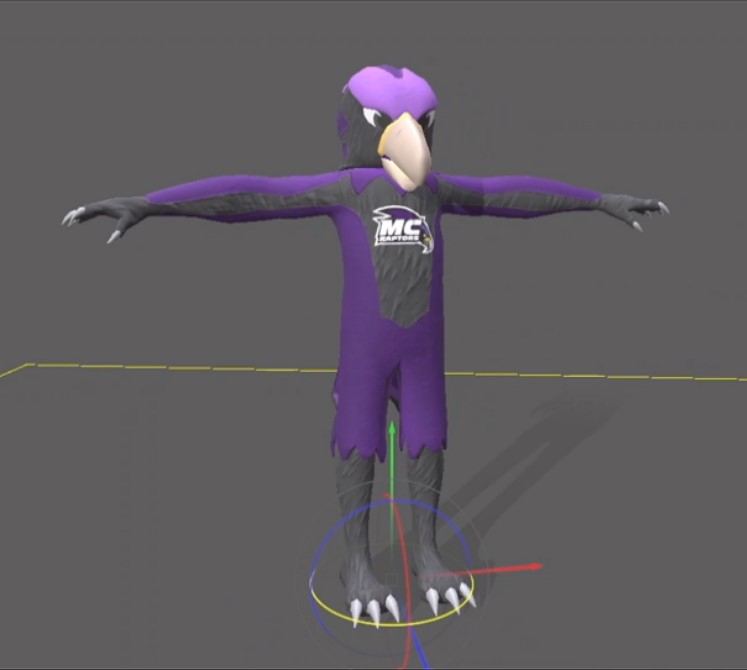
Hi everybody! I am the avatar of the Montgomery College Mascot in Maryland, USA: the Raptor. There I am part of a medical simulation scenario that helps students learn and train for their future job. If you are wondering what a digital human like me does and how a non-human avatar is created, keep reading!
What does a digital mascot do?
Now, before you worry that birds are taking over the blog about digital humans, lets clarify: can I be a digital human if I’m not even human? Well, if I’m not a digital human, then maybe I’m a digital mascot? That’s a whole new term… Better not to get lost in the technicalities, I’m antropomorphic, it’s close enough! Still, when you think medical simulation, a mascot is not the first thing that comes to your mind. So what am I doing on the e-REAL walls at Montgomery College? The simple answer is: I do what mascots do! This doesn’t tell you anything? Ok, let me explain…
If you’ve never taken part in a medical simulation and you’ve never seen an e-REAL interactive wall, you probably don’t know what to do with it. And here is where I appear and greet you. I not only represent my school in explaining what the simulation is about and why it was created, but I also help the participants understand how to properly take advantage of all the functions the interactive walls offer. Because if you thought that you just touch some digital buttons and it’s all going to work out, you are in for a surprise. We’re talking shared movable notepads, digital documents you can access, 3D movable medical tools, simulated medical test results and so much more!
I help, I guide, I cheer you on and motivate you when you are struggling and I make sure that overall your experience whith this medical simulation is great and educational. And if you are particularly lucky, my amazing charisma might prevent your professor from noticing that very stupid mistake you just made. Shhht, put it back and no one will ever know, Raptors word!

The animation of digital humans
But what is really so special about me, is how I’m made. If you think of mascots, most of you probably picture a human wearing a costume, so there is the outer costume layer and then the human inside. Digital humans have a double layer too, but not quite the same. There is an exterior, pshysionomical layer that defines the appearence, and then inside you’d find a very elaborate skeleton that allows them to move the different body parts. 3D modelers and programmers call it a skeleton, but they’re not the kind of bones you are thinking of: they appear as colored lines that represent the singular parts that can be moved independently.
No matter how elaborate the skeleton of a digital human is, the skeleton inside a digital mascot like me is on a whole other level, because oh wonder, humans don’t have beaks, tallons and wings they have to move! This bird has no standard skeleton, it’s all custom made! To create this intricate details of the Raptors costume and allow them to move and be part of the animation instead of just being strictly an aesthetic feature was a fun challenge for the e-REAL team, and they did great! I haven’t tested my wings yet, but I could probably fly if I wanted, I’m not just that sure that my digital bones are gravity defying… what do you think? Nevermind, I’ll test it later.
If you want to better understand how a digital humans’ inner skeleton works, here is a short video about the movement of my body.
Digital humans in medical simulations
As I told you, I’m part of a medical simulation used by students. Since digital humans don’t even have the same skeleton as you, you could wonder why practice medicine on them. First of all, a digital medical simulation is a good way to practice what actions to do in specific situations, like what tasks to do in what order, what utensils to use and so on. Being digital, it allows multiple people to take part totgether, making it ideal for a class, and since you don’t have to use real equipment because you have digital replicas of it, it can be used on actual patients. So it’s actually a smarter use of resources! But that’s not all, because the most important part of a medical simulation with digital humans are the interactions. It’s not just your classmate – who lets be real, isn’t the greatest actor you’ve ever seen – lying there on the gurney and pretending to be a patient, but an avatar that can be programmed to play a huge variety of different characters. And the e-REAL avatars not only perform actions and dialogues, but are also able to show emotions just like human patients do. This gives the students a chance to try themselves in very specific situations with maybe particularly hostile or not very communicative patients, and so practicing for future real life situations. Since this situations tend to always be stressful, when they will happen, I think the students will be very happy to have had a chance to pratice before and this will give the patient better quality care. This is why I’m so proud to be a digital mascot: with my work I get to really help the students be the best they can!

I think I’ve talked enough for today, I hope you learned something interesting, so that I can say that I’m not only educating students at Montgomery College anymore, but you too! The DigiBlog will wait for you next week with a new digital human, don’t miss it!
